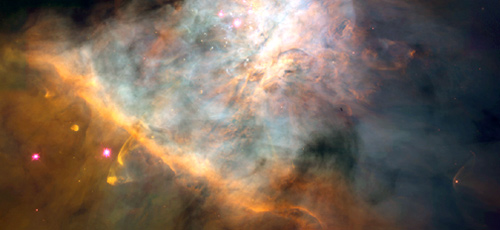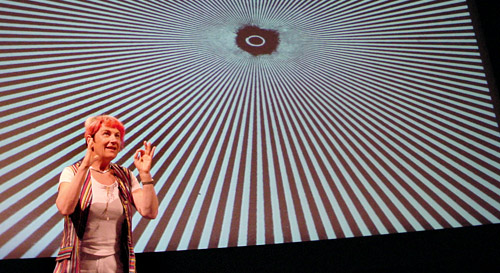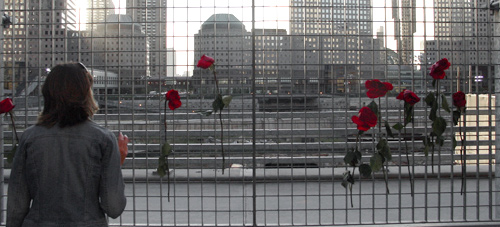This Evening!
Michael Shermer on Art Bell’s
Coast to Coast AM radio show
Monday, January 23rd
11pm—2am, Pacific Standard Time
Tonight, Michael Shermer will appear on Art Bell‘s Coast to Coast AM national radio show. George Noory presents the “Skeptics Cage: Two go in, one comes out.” Michael Shermer will be debating one scientist each hour on various aspects of new scientific thought. The line-up: Dr. Gary Schwartz, Russell Targ, and Dean Radin. You can tune in live on AM radio stations across the US (free), XM radio channel 165, or you can pay for a subscription to the podcast from the Coast to Coast AM website.

This image of the Orion Nebula reveals at least 153 glowing protoplanetary disks (dubbed “proplyds”) that are believed to be embryonic solar systems that will eventually form planets. (NASA image courtesy of GRIN)
lecture reminder…
The Soul of Science
Bootstrapping Meaning, Purpose & Spirituality
with Dr. Michael Shermer
Friday, January 27th, 9:30 am
at James Randi’s The Amazing Meeting 4
at Stardust Hotel, Las Vegas
How can we find spiritual meaning and purpose in a scientific worldview? Spirituality is a way of being in the world, a sense of one’s place in the cosmos, a relationship to that which extends beyond our selves. There are many sources of spirituality; religion may be the most common, but it is by no means the only. Anything that generates a sense of awe may be a source of spirituality. Science does this in spades. Dr. Shermer shows how.

Susan Blackmore speaking at the 2005 annual conference
Brain, Mind & Consciousness
– our 2005 conference now on DVD!
A three DVD set of the Skeptic Society’s “Brain, Mind & Consciousness” conference is now available. Held at Caltech in May 2005, this includes 30–50 minute talks by Michael Shermer, Roger Bingham, Christof Koch, Alison Gopnik, Richard McNally, Terry Sejnowski, Susan Blackmore, John Allman, Paul Zak, Hank Schlinger, and Ursula Goodenough.
READ Lee Traynor’s synopsis of the conference >
The Environmental Wars:
The Science Behind the Politics
– announcing our 2006 annual conference!
June 2nd–4th, 2006
California Institute of Technology
with Dr. Brian Fagan, Dr. Gregory Benford, Dr. Donald Prothero, Dr. Michael Shermer, special guest Michael Crichton, and others to be announced.
Every year the Skeptics Society hosts a conference which sees skeptics from all across North America and Europe converge for lively conversation, debate, and collaboration. Each conference centers around a specific theme, which allows us to cultivate an expert and informative panel of guest speakers.

photo of “Ground Zero” by Roderick Yang
In this week’s eSkeptic, we present Richard Morrock’s review of The New Pearl Harbor: Disturbing Questions about the Bush Administration and 9/11, by David Ray Griffin (Olive Branch Press, 2004, ISBN 1566565529)
Richard Morrock is a writer based in New York. He has been active with the skeptics movement and has lectured on a variety of subjects to skeptical groups in New York and Philadelphia. He is also involved with the International Psychohistorical Association, of which he has served as vice president and newsletter editor. He is currently working on a book on psychohistory, along with a musical comedy based on the first term of the Bush administration.
9/11:
A Date That Will Live in Infamy
review by Richard Morrock
David Ray Griffin’s fanciful tale of Bush administration complicity in the 9/11 terrorist attack is a perfect example of the kind of conspiratorial thinking discussed by George Case in Skeptic Vol. 11 No. 4. There isn’t much to be learned about the fateful events from Griffin’s silly book, but he gives us some useful insight into the origins of paranoia.
Most writers on a subject do what is called research on the material, which means reading books, conducting interviews, and tracking down documents. This consumes far too much time and effort for conspiracy buffs like Griffin. His approach consists of asking disturbing questions, ignoring the actual evidence, speculating about the possible answers, assuming the worst-case scenario, and then drawing up his indictment of the administration based on his assumptions, even where they are in flagrant contradiction to widely-known facts.
Starting with the dubious “who benefits argument?”, Griffin concludes that since President George W. Bush profited in terms of political capital from the 9/11 attacks, he had to be behind them. Given that premise, he argues that the U.S. government masterminded the whole catastrophe from beginning to end, with the al-Qaeda hijackers being either innocent bystanders or U.S. secret agents. The planes that hit the World Trade Center — Flights 11 and 175 — were actually piloted by remote control, with their command center at No. 7 WTC, the 45-story office building across a narrow side street from the North Tower. In addition, the impact of the planes did not cause the buildings to collapse; that was the work of controlled explosions set off inside the Towers. As for the Pentagon, it was a guided missile or, no, maybe a military plane that hit the building, with Flight 77 disappearing inside the smoke and flames. And Flight 93, which crashed in Shanksville, PA, was actually shot down by the U.S. military because the passengers were on the brink of taking it over. The Bush administration didn’t want the hijackers taken alive, Griffin insists, because they presumably could have proven their innocence. How strange that 20th hijacker Zacarias Moussaoui should have been kept alive after the 9/11 events, not to mention the mastermind of the affair, Khalid Sheikh Mohammad, captured in Pakistan and now in U.S. custody.
One of the points Griffin raises is why the South Tower collapsed half an hour before the North Tower, although it was struck 15 minutes later. From this alleged discrepancy in the official story, Griffin concludes that the government had planted explosives in the WTC the previous weekend, using a power blackout as cover, and had dynamited the buildings. He never considers the other explanation: the South Tower collapsed faster because the plane impacted on a lower floor, and more floors were therefore set on fire. Any glance at the photograph of the second impact will show this.
He fails to explain why the government would have waited nearly an hour to explode its bombs in the South Tower, which would have allowed many people to escape; the North Tower didn’t collapse for one and 3/4 hours, and nearly all of the WTC workers who died were in the impacted floors or above. Did Bush’s remote control have a low battery?
Griffin actually does claim that No. 7 WTC, which collapsed at 5:20 pm, was blown up by explosives, and this is taken as proof that Washington was behind it. But what would the motive be? Blowing up an already-evacuated office building after thousands had died in the Twin Towers would seem like a waste of dynamite, not to mention office space. Did Bush think that public opinion had not been sufficiently inflamed by the 3,000 deaths? Do most Americans even know that a third office building, far smaller than the Towers, was also lost on that day? Griffin never explores that possibility that No. 7 was demolished because it had been contaminated by the white dust from the nearby North Tower. Explosives were used because, at 45 stories, No. 7 was too tall for a wrecking crane.
Jet fuel is kerosene, argues Griffin. Kerosene could not have caused a fire hot enough to melt steel, which happened at the Twin Towers. Perhaps Griffin has never attended a barbecue, where kerosene is used to ignite charcoal briquettes, and the charcoal fire then cooks the food. Something similar happened at the Twin Towers, where the jet fuel ignited carpets, furniture, books and papers, which then produced enough heat to bring down the burning floors; their impact on the floors below produced the force that led to the Towers’ collapse.
There is the question of what Bush knew on the morning of 9/11 and when he knew it. Some have claimed that Bush was lying when he said he saw the first impact on the Twin Towers, since there had been no live coverage of that attack; the second impact, about 15 minutes later, was covered by cameramen photographing the fire from the first. It would seem likely that when Bush watched the second crash on TV, as he waited to enter the 2nd-grade classroom in Florida where he was planning to read My Pet Goat, he mistakenly thought he was watching the first. Not until about 20 minutes later was he informed that there were two crashes, indicating a terrorist attack rather than an accident, and at that point he started to look worried. About six or seven minutes later, he left the school.
Well, why wasn’t he, or his staff, concerned about his being targeted by the terrorists? Doesn’t that prove, as Griffin indicates, that Bush was aware he was in no danger, and therefore involved in the attack? Not necessarily, given that both attacks were in New York, a thousand miles from Florida, and the attack on the Pentagon hadn’t happened yet. Furthermore, it is unlikely that the hijackers could have singled out the Sarasota elementary school; all of their targets were highly visible landmarks which could be identified from many miles away, whereas urban areas have numerous indistinguishable schools.
Why wasn’t the Air Force ordered to shoot down Flight 77 as it streaked through the sky on its way to hit the Pentagon? The official 9/11 Commission story is that planes were sent north to intercept Flight 11, with the White House and Pentagon unaware that it had already crashed in New York, and that the threat was coming from another plane, heading in from the west. Griffin believes that Vice President Dick Cheney, in charge of the situation in Washington while Bush was flying to Nebraska in Air Force One, deliberately avoided intercepting Flight 77 so that the Pentagon would be struck. One wonders what Donald Rumsfeld, still in his office at the Pentagon, might have had to say about that! Griffin asks why the Pentagon wasn’t evacuated, but never considers the fact that the government had no idea which target in the Washington area had been selected by the terrorists. Nor does he concern himself with the political fallout if an enemy attack on United States soil had been followed by our military leadership fleeing in panic from their still-intact offices.
Then there is the matter of the disappearing wreckage at the Pentagon, of which conspiracy buffs have made much. Photographs taken in the immediate aftermath of the impact show no sign of airplane debris. That must mean that it was a missile that hit the Pentagon, implicating our diabolical government once again. Official accounts indicate that Flight 77 smashed through several of the concentric rings that make up the Pentagon, so that the wreckage all came to rest well inside the building.
Flight 93, which crashed in rural Pennsylvania as the passengers attempted to wrest it back from the hijackers, may actually represent the one instance where Griffin does cast some light on the matter. The original official story had it that the passengers made their way into the cockpit, but that the plane crashed during the brief struggle. Later, it was announced that the passengers never made it through the door, and the government speculated that the pilot, Ziad Jarrah, downed the plane as the desperate fight broke out in the passenger compartment. Of course, given the fact that Jarrah planned to sacrifice his life for this mission, it doesn’t seem likely that he would have aborted it while there was still some chance of success. Griffin indicates that open cell phone lines recorded two explosions during the fight, followed by the sound of rushing wind; he reports an eyewitness saying that the plane disintegrated in the air, and mentions that one engine was found a mile and a half from the rest of the debris.
This is proof to Griffin that the Air Force downed Flight 93 with a missile, making the government responsible for the deaths of the heroic passengers who nearly foiled the fourth hijacking. He backs up this improbable claim by mentioning that someone saw a white military plane in the sky near the hijacked flight, overlooking the detail that military planes on such a mission would travel in formations of two or more, and that they are rarely white.
Griffin also mentions that the Flight 93 hijackers declared that they had a bomb when they took over the plane, but that the passengers regarded this as a bluff. He never considers the possibility that the hijackers were not bluffing, and that they set off the bomb (more likely two) when they were rushed by the passengers. This would account for the explosions, the sound of the wind on the cell phones, the crash of the plane, the engine landing more than a mile from the fuselage, and the peculiar path of the flight in the last few minutes before it crashed. In the map in the 9/11 report, Flight 93 makes a U-turn in northern Ohio after being hijacked, and then heads southeast, in a straight line, aiming directly for Washington. While over western Pennsylvania, it veers to the left and then makes a clockwise semi-circle, as if Jarrah has suddenly found it impossible to steer. Was this the result of a missile, a fight in the passenger compartment, or the desperate hijackers setting off their bombs?
The 9/11 attacks made Americans feel helpless, even more so than our defeat in Vietnam. Theories of administration complicity in 9/11, based on total denial of even the most self-evident facts, serve as a defense against these admittedly uncomfortable feelings, and allow us to feel omnipotent once again. Our government is all-powerful and all-knowing; a bunch of Middle Eastern fanatics couldn’t possibly take us by surprise, could they? Better a government that’s totally evil than one which leaves us helpless in the face of foreign terrorists.









